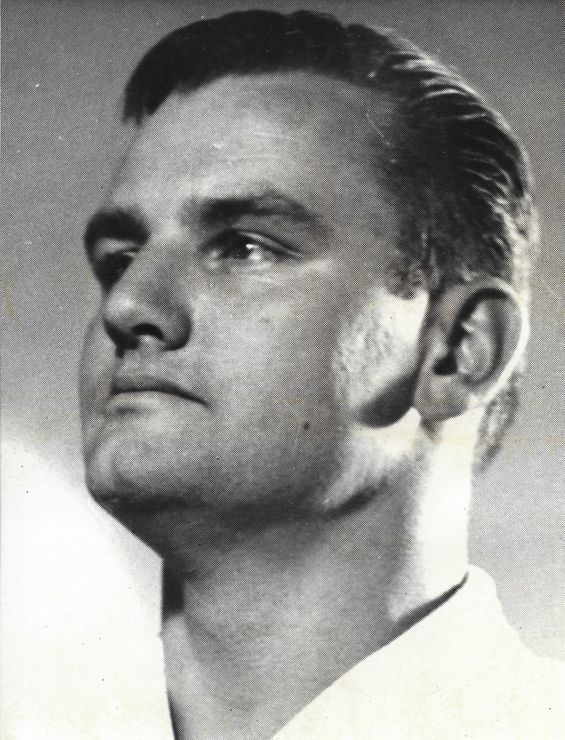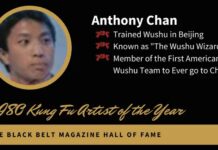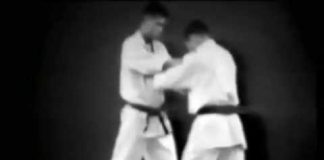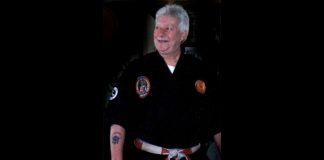A few years ago at a major martial arts conference, I and the number of karate instructors from all over the U.S. sat around the table discussing various topics. At one point, one of the topics that was brought up was who was the most important person responsible for the spread and the growth of karate in the U.S. Various names were bought up. Some felt the honor went to Ed Parker who was one of the first karate instructors on the West Coast, another felt it was Robert Trias from Arizona who opened the first karate dojo in Phoenix in 1946. Some of the other names that were mentioned included famous Shotokan karate master Hidetaka Nishiyama, Fumio Demura, Peter Urban and Aaron Banks. Someone even felt that famous Kyokushinkai master Mas Oyama should be included since he came to the U.S. in the early 1950s and did karate demonstrations at major sport centers raising an interest in karate. When it was my turn, I claimed that it was Bruce Tegner who was the man most responsible for helping spread karate in this country. I pointed out that in the late 1950s when almost no one ever heard of karate, Tegner’s books were read by tens of thousands of readers. Over the years he wrote close to two dozen books on the various martial arts and, in my opinion, he influenced the growth of karate as well as other martial arts more than any individual that had been mentioned earlier.
Instantly almost everyone at the table attacked Tegner as a phony and someone who knew nothing about karate or any other martial arts that he wrote about. The reaction didn’t surprise me. Over the years many traditional martial arts instructors went out of their way to speak ill of him and ridicule his reputation. These instructors were petty, cruel, mean and short sighted.
In my opinion during the infancy of martial arts in this country, Tegner was by far the most prolific American martial arts writer in the U.S. His numerous books which included books on karate, judo, aikido, savate, stick fighting and practical self defense were published as mass paperback books that got wide circulation around the country and enticed thousands of people into a dojo. These books were inexpensive enough to be affordable by most readers, and many of his books have been translated into various languages worldwide.
Most of Tegner’s critics never realized that he was bought up by parents who were both judo black belts, and his martial arts education began the moment he could walk. His mother June and father Jon began their judo training in the late 1920s and by the 1930s ran the largest judo club in Chicago where Bruce was born in 1929. His mother was one of the earliest female judo black belts in the country and in the mid 1930s she bought famous judo master Shoto Kuwashima to Chicago, and tiny Bruce began his training in judo under his guidance for many years. Over the years his parents introduced him to numerous experts in the various martial arts and by the time Bruce and his family moved to the West Coast, he was a top martial artist. He was among the first to open a large dojo in Los Angeles in 1952 where he taught judo, karate, jujitsu, aikido and practical self defense and his own Jukado system. He and his parents were among the first black belts to get involved in teaching Hollywood celebrities martial arts combat for the screen. It was Bruce who first demonstrated karate on American television when he played a karate instructor on the TV show The Detectives with Robert Taylor. The episode was in titled Karate and was aired on January 8, 1960.
Almost a year later on March 29, 1961, Bruce gave even more exposure to karate when he and his black belt student Ricky Nelson demonstrated their karate skills on one of America’s top TV shows The Adventures of Ozzie and Harriet. Many years later, Ed Parker told me that the exposure of Ricky Nelson demonstrating his karate skills on TV led to numerous other Hollywood celebrities getting involved in the martial arts. He also admitted that over the years a large number of potential students walked into his Pasadena and Santa Monica dojos with a karate book written by Tegner. I had heard similar stories from other well known senseis around the country. Parker also told me that it was because of the Ozzie and Harriet show that actor Rick Jason began training with him, and this led to Jason doing a TV series called the Case of the Dangerous Robin, where he played an insurance investigator who was also karate expert. In the series, which aired in 1961, Jason used his karate skills in almost every episode.
What also made many martial artists at the time dislike Tegner was his unique philosophy on the art of self defense. He advocated combining or integrating different styles of martial arts into a system for practical self-defense. His system called Jukado, which combined judo karate and aikido, went against the other American and Japanese martial arts experts who felt that combining the different arts was tantamount to heresy. During that time each dojo taught only one martial arts style whether it was judo, karate, ju-jitsu, etc.
Each martial art was to stand on its own merits or demerits. Karate was not mixed with judo or ju-jitsu, and often most karate instructors at the time even considered it a sacrilege if a student of one karate style tried to consider studying another karate style. Because of this, Tegner became a very controversial figure in the American martial arts community, and no one realized that he was simply ahead of his time.
Tegner did not concern himself with gaining fame in the martial arts world. He believed that teaching self defense had to be taught completely differently than traditional martial arts. He felt anyone could learn an effective method of personal defense without spending years studying the arts. He described his viewpoint in this manner: “ The principal obstacle to learning and teaching practical self-defense is the persistence of concepts and practices which do not serve our present needs. It is time to examine and re-evaluate outdated ideas on the subject of self defense.”
He defined practical self-defense by stating, “Self-defense is not warfare, it is not personal vengeance, it is not ritual or ceremony, it is not an art, it is not a sporting event, it is not a way of life, it is not a spectacular TV movie fight scene. Self defense instruction is preparation against the possibility of an assault, it is training to learn and use a group of simple and effective physical actions if no other alternative is available.”
Learning self-defense is primarily the process of learning how to avoid being a victim. According to Tegner in martial arts training there was too much emphasis on becoming a formidable fighter and not enough emphasis on how to be psychologically and mentally prepared in dealing with a physical assault.
For Tegner one had to be assertive in handling physical aggression. Tegner stated that the rational alternative to aggression is not submission but assertion. He decried and found fault with the fact that one had to to be a black belt or a savage fighter to survive a street attack. Battlefield fighting had no place in his self defense system. He advocated that students use just enough force to subdue their attackers and the only time one was justified in using lethal force was in a life and death struggle.
Tegner also made a clear distinction between sports martial arts and street self-defense. He felt that sports martial arts required technical skill, conditioning, strength, agility, endurance and a competitive nature; whereas basic self-defense required determination and the ability to learn a limited amount of simple practical and effective techniques that will work especially since the defender will most often have the element of surprise on their side when defending themselves against an attacker who thinks the victim is helpless.
Tegner did not consider self-defense on art, he considered it as a practical skill. He felt that most people do not have the time or interest to study traditional martial arts because it was time-consuming and often took a lifetime to learn. Because of this, the vast majority of traditional instructors condemned Tegner. They denounced the fact that Tegner was attacking the basic fundamental beliefs and traditions of the Asian martial arts.
Although Tegner was trained in the classical Japanese martial arts, he felt that this type of training was a hindrance to most Americans and because of this many claimed he was a fake, a fraud and a renegade.
In reality, Tegner was a very talented and gifted martial artist and was an excellent instructor with a large following. He was way ahead of this time, and his training philosophies, ideas and theories are being used at this time by the many “reality-based” martial arts courses that combine all the different martial arts styles for practical self defense training
Many years later when Bruce Lee founded Jee Kune Do, he borrowed techniques from a variety of fighting styles just as Tegner did years earlier. Today Krav Maga, a widely practiced “reality based” martial arts system, borrows heavily from all different fighting systems. Its founder Imi Lichtenfeld incorporated techniques from a large variety of martial arts, and he felt no matter what the system, if it works it should be incorporated it into Krav Maga.
Today mixed martial arts is widely excepted and no one questions these fighters from incorporating various martial arts in their training. Something Tegner advocated 60 years earlier.
I remember meeting Tegner in 1966 at his dojo on Sunset Blvd in Hollywood. I found him to me amicable and very pleasant. He invited me to watch his class, which I found to be very professional, and his students were all very capable. Although at the time I was heavily involved in traditional Japanese martial arts I was impressed with Tegner and his philosophy had much merit. Over the years I saw him on numerous occasions before he closed told his dojo in 1967 and moved to Ventura where he continued to teach self defense at Moorpark College until death in 1985.
Although he was not a great believer in martial arts as it was taught at the time, through his books he did get hundreds of thousands of people involved in learning traditional martial arts all over the country. I find it sad that Tegner was never given the credit he deserves as one of the great martial arts pioneers in this country because to me, he was by far more responsible for spreading not just karate but all the martial arts in the U.S. than most. Ever since Tegner’s passing I have thought about his death and I recall the words of the French writer Voltaire. “It’s not how a man dies that is important but how he lived.” Tegner lived a good and honorable life and that is how he should be remembered.







